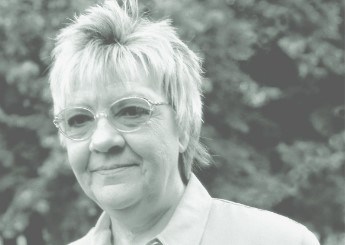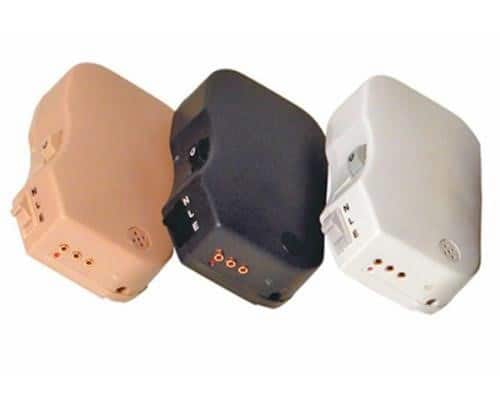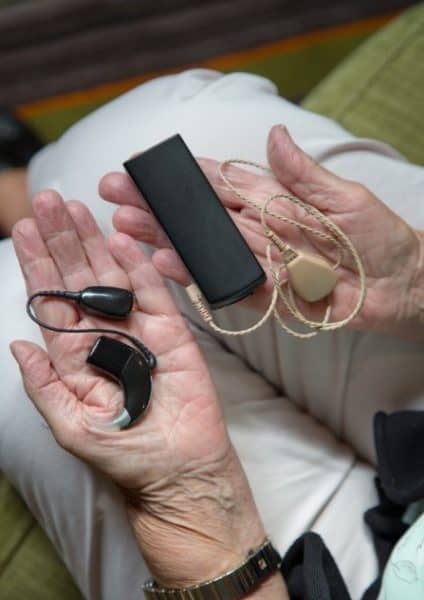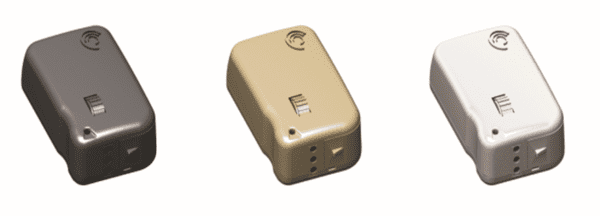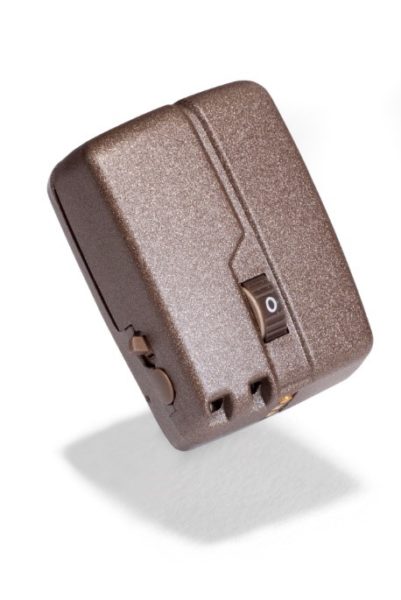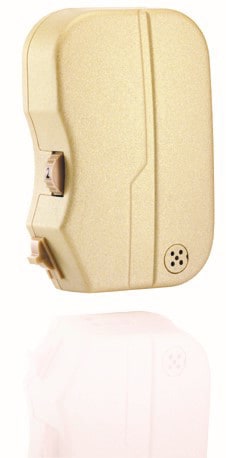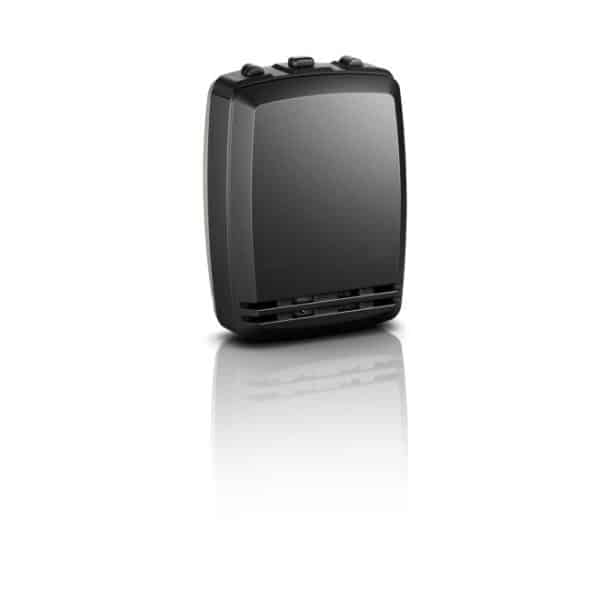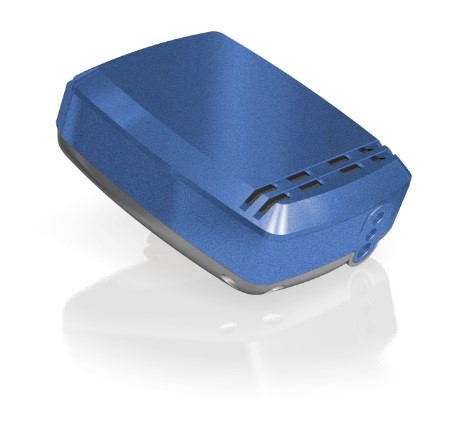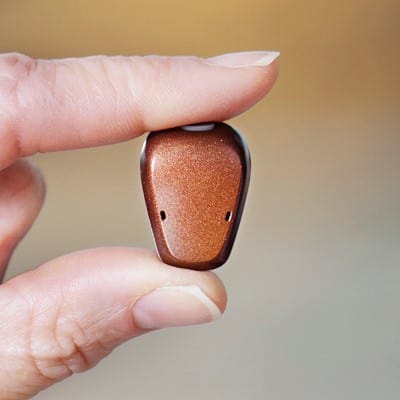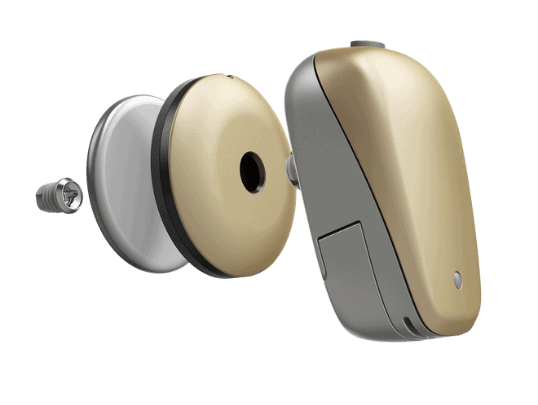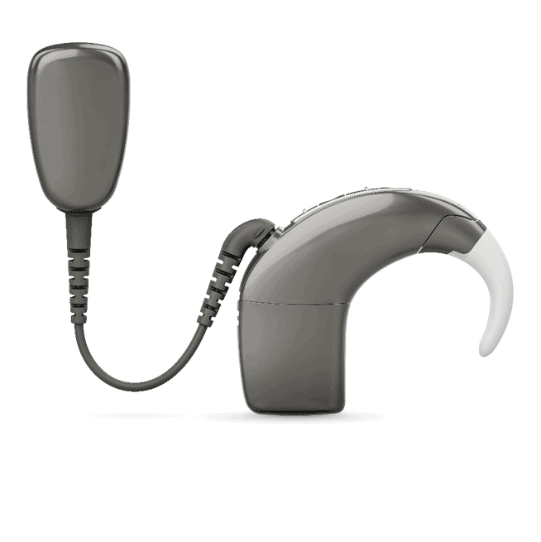In 1977 Mona Andersson became the world’s first recipient of a bone conduction implant. Since that momentous time, over more than four decades, bone conduction technology has evolved and improved building to the launch of the Cochlear™ Baha® 6 Max Sound Processor. From the HC-100, the first head-worn prototype, to the small and powerful Baha 6 Max, bone conduction technology has continued to develop through an exciting journey helping thousands of recipients around the world hear better and stay connected to the life they want.
“…my biggest wish was to hear my daughter’s voice,” said Mona, the world’s first recipient of a bone conduction implant.
Picture: World’s first recipient of a bone conduction implant, Mona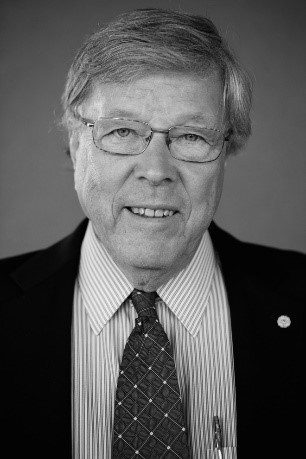
Picture: Dr. Anders Tjellström
40 Years of Baha
After struggling with chronic infections from scarlet fever and hearing loss since she was a child, by the age of 40 Mona said, “I had nothing to lose when I accepted Dr. Tjellström’s proposal to receive a bone conduction implant.” In 1977 bone conduction technology was beginning to emerge, thanks to the continuous efforts of Professor Brånemark and Dr. Anders Tjellström.
In 1982, a unique collaboration between Anders Tjellström, Bo Håkansson and Peder Carlsson, Professors at Chalmers Institute, resulted in the development of the first bone conduction prototype.
1987 – 1997: more innovation, new countries and the first five thousand patients
The interest and awareness of the intervention spread across Europe throughout the 1980’s, with increasing numbers of clinical reports revealing positive outcomes in implant recipients. In the UK, the Netherlands and Sweden in particular, the treatment became more common and part of a choice of options available to people with hearing loss.
Picture: The Classic 300 Sound Processor was launched in 1993
The world’s first bone conduction sound processor, the HC-100, which became commercially available in 1985, was followed up by an improved version in 1988 – the HC-200. Within a few years another new processor was launched, the Classic 300, followed closely by the Baha 360 model. Both new processors took considerable steps toward increasing the ease of use of the system. Patients who were fitted with a bone conduction hearing system in the 1990’s reported increased comfort as compared to conventional hearing aids.1 2
A very important milestone was reached in 1996, when the FDA approved the use of the Baha System in the USA. The result of opening such a big, new market was simply amazing – by 1997, five thousand people were hearing better with the help of the Baha System!
The year of 1997 was also marked by another crucial event – the launch of the Baha Cordelle. It was the world’s first super power device, designed for people with more severe hearing loss. This meant that people who had struggled to hear, despite attempts with hearing aids, would now have access to power levels high enough to compensate for their hearing loss. The Baha Cordelle was also equipped with the first generation of snap coupling that improved the connection between sound processor and implant.
1997 – 2007: the dynamics of an industry in full motion
From 5,000 users in 1997 to a staggering 50,000 by 2007, the industry drove innovation in technology and expanded to even more geographical locations. It would no longer be an emerging practice, but standardized treatment for people with conductive hearing loss, mixed hearing loss, and single-sided deafness (SSD).
A further improved version was released in 1999 (together with a new abutment) that would come to fully replace the bayonet coupling that the previous Baha System had used. This coupling remains the standard coupling technology seen in today’s systems.
The first sound processor to feature the new snap coupling was the Baha Cordelle II, also released in 1999. The new processor replaced the previous Cordelle by improving the body-worn unit. A year later, in 2000, the Baha Compact would be introduced to replace the Baha 360, and feature improved electronics and an optional directional microphone.
Picture: Baha Compact sound processor
The world’s first non-implantable Baha solution, the Baha Softband3, was released on the market in 2002. The Softband allowed children to benefit from a Baha System before they were ready for an implant. To date, it is still the recommended solution for pediatric treatment (until a child is ready for an implant) and for demo/trial purposes.
2005 is another year that marked a major trajectory shift in the bone conduction industry. It was the year that Cochlear Ltd acquired the Swedish company Entific Medical Systems, the company that had been developing and manufacturing the Baha System as a spin-off from Nobel Biocare (originally Bofors Nobelpharma, a company that was formed to industrialize Brånemark’s osseointegration discovery). A new Cochlear division was set up, Cochlear Bone Anchored Solutions AB, and this division took over the manufacturing and development of the bone conduction system under the Baha brand. That same year, Cochlear launched the Baha Divino Sound Processor. It was the first digital sound processor, a technology that helped to further improve hearing outcomes and allow users greater control.
Picture: Baha Divino, the world’s first digital sound processor
In 2007, Cochlear launched another sound processor, the Baha Intenso, which was the first head-worn power device. Like the Baha Divino it also featured digital signal processing. This new, complete portfolio gave more people more options; with three devices suitable for different levels of hearing loss – the head-worn Baha Divino (for up to 45 dB SNHL) and Baha Intenso (for up to 55 dB SNHL) and the body-worn Baha Cordelle II (for up to 65 dB SNHL).
Picture: Baha Intenso, the world’s first head-worn power sound processor
2007 – 2017: visions of tomorrow in state-of-the-art technology
When Professor Brånemark accidentally discovered osseointegration in the 1950’s, the scientific community was startled in mistrust. To even dare to think that titanium, an inorganic element would fuse with bone tissue, let alone to try to evolve the observation into scientific research, was considered outrageous. Over the years, the applications of his discovery spread from dental implants to hearing devices, and today millions of people benefit from osseointegrated solutions.
“Technology has come a long way. A sound processor that has the capacity to adapt to different noise environments was something we had never imagined possible all those years ago”, said Dr. Anders Tjellström in an interview referring to the current generation of sound processors from Cochlear.
In 2009, the Baha BP100- the first fully programmable sound processor built exclusively for bone conduction was launched. The processor improved speech understanding by up to 25% compared to the previous generation (Baha Divino).
Picture: Baha® BP100
In 2011, Baha BP110 Power was to be the first power sound processor with advanced automatic signal processing and it delivered more than 50% improved speech understanding in noise compared to the previous generation (Baha Intenso).
Another major breakthrough took place in 2013 with the launch of the Baha 4 Sound Processor. It was the world’s first wireless processor, and was available with a complete range of wireless accessories. While it looked like the previous generation BP100, the inside was totally new and it featured, again for the first time, a scene classifier that automatically adapted to the sound environment to improve the hearing experience.
But in 2013 a new abutment would revolutionize the industry. The Baha BA400 (DermaLock™) was the first abutment designed and approved for soft tissue preservation surgery. From 1977 until 2013 the soft tissue around the abutment needed to be removed in order to stabilize the area surrounding the abutment. With a new hydroxyapatite surface designed to integrate with soft tissue, the DermaLock Abutment let surgeons leave the surrounding soft tissue in place, drastically improving the aesthetic results, reducing surgery time and speeding up healing. This is now the standard procedure, and soft tissue reduction is a thing of the past.
Picture: Baha 4®, the world’s first wireless sound processor
Picture: The Baha® 5 Sound Processor is the world’s smallest sound processor, and the only device in its class equipped with Made for iPhone® technology
In 2015, with the launch of the Baha 5 Sound Processor, two new technologies emerged that would make the new processors not only much smarter, but also much smaller – without losing any power. The first of these technologies was a totally new symmetrical transducer, BCDrive™, that was twice as efficient as the previous design. For the Baha 5 Sound Processor, this efficiency was used to decrease the size of the transducer, which directly relates to the overall size of the processor. It made the new processor more than 20% smaller than the previous version and opened up the possibility of a new design aesthetic. The sleek design, ergonomics and usability of the device were recognized when the Baha 5 received a Red Dot Design Award in 2015.
The second breakthrough technology allowed direct streaming and control from Apple®4 devices. The Baha 5 was the first sound processor to be equipped with Bluetooth Smart, a low energy Bluetooth®5 protocol built for the Internet of Things (IoT). It allows the exchange of data between the sound processor and iPhone® with minimal energy consumption, and is used in most wearable devices today. To exchange simple data is one thing, but to make it possible to stream sound this way requires additional work and technology development. That’s where Apple comes into it. Apple had worked with the hearing aid and implant industry and developed Made for iPhone6 Hearing Aid technology, which made this direct streaming possible. The Baha 5 System, with the Baha 5 Sound Processor, was the first implantable hearing system to feature Made for iPhone technology, allowing people to stream sound directly from iPhone and iPad® devices directly to the ear! At the same time, a Smart App (Baha 5 Smart App7) was released that allowed people to control their sound processor directly from the phone, without the need for any additional devices like neck-worn dongles.
Incredible technological transformations
Innovative products continued to be developed to broaden the choices available to people with conductive hearing loss, mixed hearing loss and SSD. The Baha Attract System, the world’s first magnetic osseointegrated system, became available in 2014. With its release, the Cochlear Baha System offered more possibilities than ever before. Now people could choose between an under-the-skin magnetic implant, an abutment system, or a non-surgical solution like the Baha Softband which was designed for children too young, or not ready, for an implant.
Picture: The Baha® Attract system – a Baha 5 Power sound processor with a magnetic connection to the implant
Picture: Isabella, Baha Attract recipient
The 2015 launch of the Baha 5 Sound Processor, the world’s smallest & smartest, was followed a year later by the power and super power versions. The Baha 5 Power and the Baha 5 SuperPower provide a fitting range of 55 dB SNHL and 65 dB SNHL respectively, and are designed for patients who need additional amplification due to a higher degree of hearing loss.
Picture: The Baha® 5 SuperPower, first head-worn super power processor
The Baha 5 SuperPower Sound Processor used a unique split-system design that ensured there was enough power to help people with more severe mixed hearing loss, but also gave them the ease and aesthetics of a head-worn solution. Both the Power and SuperPower used the same two revolutionary technologies – BCDrive and Made for iPhone – as the Baha 5 Sound Processor to provide excellent sound quality and direct-to-device wireless streaming.
Picture: Baha 6 Max Sound Processors
2021 – Introducing the Baha 6 Max Sound Processor – Small Never Sounded So Powerful
The last four decades have seen great advances in bone conduction technology culminating in the next evolution in sound: the Baha 6 Max Sound Processor. With a fitting range of up to 55 dB SNHL (sensorineural hearing level) in the same small size as current 45 dB devices8, the Baha 6 Max is the first of its kind: a premium-power bone conduction sound processor designed for powerful hearing performance. The Baha 6 Max is also the first bone conduction sound processor to offer direct streaming from Apple and AndroidTM9 devices.10 The new processor provides additional power in the smallest form11 12 and is designed to provide the most clear, rich and natural sound possible–reducing the need to choose between hearing performance and size. 13 14 15 16 17
Learn more about the new Baha 6 Max Sound Processor
- Land J. Comparison tech data Baha 6 Max, legacy and competition. Cochlear Bone Anchored Solutions AB, Sweden. 2020; D1762475.
- “Baha – A Third Option for Otosclerosis”. Nobel Biocare International Updates 2/96. Volume 5, No.2, 1996, pp. 3
- The Baha must be fitted/used on a softband for recipients ages 5 and under.
- Apple, the Apple logo, FaceTime, Made for iPad logo, Made for iPhone logo, Made for iPod logo, iPhone, iPad Pro, iPad Air, iPad mini, iPad and iPod touch are trademarks of Apple Inc., registered in the U.S. and other countries. App Store is a service mark of Apple Inc., registered in the U.S. and other countries.
- The Bluetooth® word mark and logos are registered trademarks owned by Bluetooth SIG, Inc. and any use of such marks by Cochlear is under license.
- The Baha 5 Sound Processor featuring the new Ardium™ Smart platform is the first sound processor that can stream sound directly from an iPhone,® iPad® or iPod® touch. No secondary device, no bulky neck-worn hardware – just clear, crisp sound directly to the sound processor.
- The Cochlear Baha Smart App is available on App Store and Google Play.
- Land J. Comparison tech data Baha 6 Max, legacy and competition. Cochlear Bone Anchored Solutions AB, Sweden. 2020; D1762475.
- Android is a trademark of Google LLC. The Android robot is reproduced or modified from work created and shared by Google and used according to terms described in the Creative Commons 3.0 Attribution License. Google Play and the Google Play logo are trademarks of Google LLC.
- The Cochlear Baha 6 Max Sound Processor is compatible with Apple and Android devices. For compatibility information, visit cochlear.com/compatibility.
- Land J. Comparison tech data Baha 6 Max, legacy and competition. Cochlear Bone Anchored Solutions AB, Sweden. 2020; D1762475.
- Hoffman J. Subjective evaluation of clear rich and natural sound. Cochlear Bone Anchored Solutions AB, Sweden. 2020; D1788013.
- In an average use case at similar prescriptions. Davidsson B. Technical Report: Battery autonomy in Baha 6 Max vs Baha 5. Cochlear Bone Anchored Solutions AB, Sweden. 2020; D1770958.
- Leung B. Technical Report: Baha 6 Max data analysis and correlation report. Cochlear Bone Anchored Solutions AB, Sweden. 2020; D1772435.
- Van Eeckhoutte M, Folkeard P, Glista D, Scollie S. Speech recognition, loudness, and preference with extended bandwidth hearing aids for adult hearing aid users. Int J Audiol. 2020;1-12.
- Hua H. Baha 6 Max Home test CIR CBAS5779. Cochlear Bone Anchored Solutions AB, Sweden. 2021; D1801512.
- Bergs T. Technical Report: Performance comparison A1 vs A2 actuators. Cochlear Bone Anchored Solutions AB, Sweden. 2020; D1770991.
